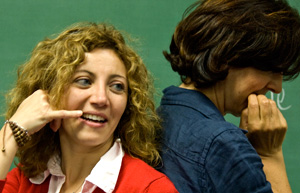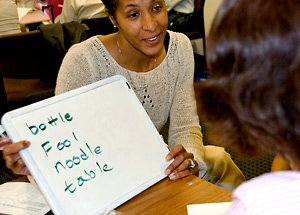 |
Pitch is emphasized in a course on American English pronunciation offered to foreign scholars. |
Foreign scholars at Berkeley say 'yes' to American English pronunciation course
 |
| 04 September 2009
BERKELEY — It was while watching Hollywood movies like "Titanic" that Noer Fauzi Rachman learned his English back in Indonesia: [Jack Dawson:] "I love waking up in the morning not knowing what's gonna happen or, who I'm gonna meet, where I'm gonna wind up. Just the other night I was sleeping under a bridge and now here I am on the grandest ship in the world having champagne with you fine people."
 Italian
scholars Maria Longobardi and Elisa Pintus practice
a telephone conversation in English. (Cathy
Cockrell/NewsCenter photos)
Italian
scholars Maria Longobardi and Elisa Pintus practice
a telephone conversation in English. (Cathy
Cockrell/NewsCenter photos)Now a doctoral student in Berkeley's College of Natural Resources, Rachman speaks Indonesian with his wife and two young sons. But when he leaves for campus — or ventures far beyond it to speak at professional meetings — it's English all the time, using vocabulary, grammar, and pronunciation learned in the glow of the silver screen. And making himself clearly understood, it turns out, is trickier than comprehending movie subtitles.
There's the letter "r" for starters. When introducing himself — "I'm a graduate student in Environmental Science, Policy, and Management" — his heavily rolled r's can conjure the revving of a Harley-Davidson. So when Rachman heard about a six-week, 12-session course, "Pronouncing American English," he eagerly signed on.
Organized by the campus's Visiting Scholar and Postdoc Affairs Program (VSPA) and paid for by the students themselves, this popular evening class, offered in spring and summer, helps prepare international scholars for academic interactions, the job market, and professional careers. Thirty-six spaces, 18 per class, quickly fill each time the course is offered, says VSPA director Sam Castañeda. "It's gotten a reputation," he says, and the potential audience is large: the campus's foreign-scholar population includes more than 900 postdocs; 1,100 visiting scholars; and 1,900 graduate students.
Meeting twice a week for six weeks, "I'm not going to turn them into newscasters," says course instructor Sherrin Loyd, a speech pathologist and voice coach. Nor is that her goal. Rather, it's to help these foreign scholars hear, and then create, sounds not found in their native languages — as well as to gain facility with an all-important feature of spoken English, pitch. While brilliant and highly motivated, Loyd notes, few of them, before now, have had help identifying their specific English pronunciation issues and how to overcome them.
 CSU
grad student Kelley Brown helps Shan Dou, a PhD student
in seismology, with her l's.
CSU
grad student Kelley Brown helps Shan Dou, a PhD student
in seismology, with her l's. Students begin with an online evaluation before the first meeting. Then, in class, they're shown where to place their tongues and how to position their lips to make unfamiliar sounds.
Loyd and her assistants — graduate students from her Cal State East Bay classes — also record the participants, evaluate their pronunciation issues, and send each home with exercises for improvement. For Japanese and Chinese speakers, that usually means work on l's and r's. For Italians — used to raising their pitch at the ends of sentences, as if asking a question — it's learning to come down in pitch, á la Americana.
The rest is practice and more practice — individually, in pairs, in groups, and with coaching from Loyd and her graduate students. Often, participants use mirrors to visualize how to form troublesome English sounds. Another device, a voice-feedback apparatus called a WhisperPhone, helps them better hear themselves.
Like all people learning a foreign language, class participants "take the rules of their first language and use these rules when trying to speak English," notes Loyd. "So if, as in Spanish and Chinese, there are few consonants at the end of their words, they'll pronounce 'talk' as 'ta' and 'rug' as 'ruh' — not understanding that the ends of words in English carry a lot of meaning."
This was true for Berkeley PhD student Jiang Long, a software engineer from China and an advanced English speaker. Though he has already mastered many of the pronunciation problems that vex beginners, he discovered in class that he was dropping his final n's and g's in English — and now has started to pronounce them.
Rachman, working on his r's, got "a really big clue from Sherrin" — learning "to change the position of my lips and tongue and to locate my tongue appropriately." Sometimes, in a very long English sentence, Indonesian-style r's still come rolling back "without my control," he admits. "It's hard. But I'm struggling to make it better."
For information on the January 2010 "Pronouncing American English" class, contact Sam Castañeda at the Visiting Scholar and Postdoc Affairs Program.

